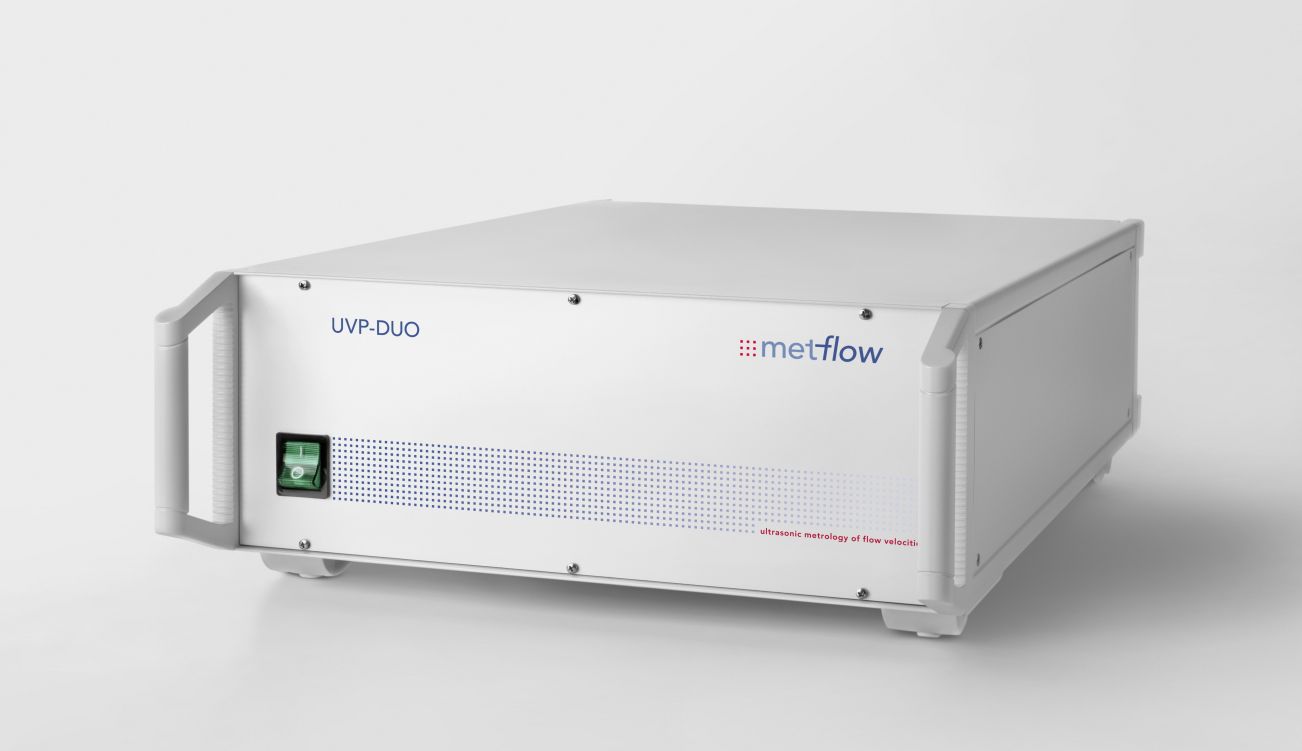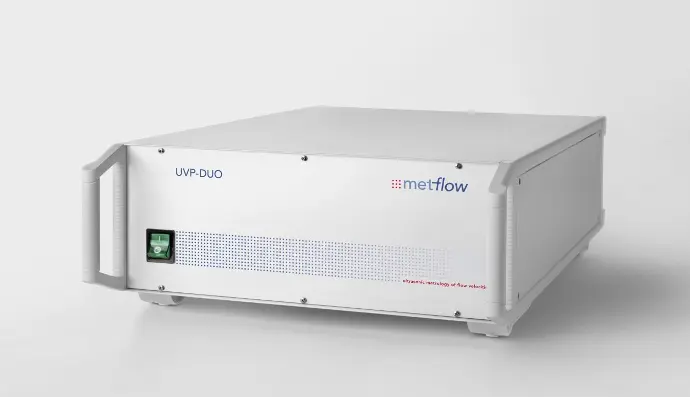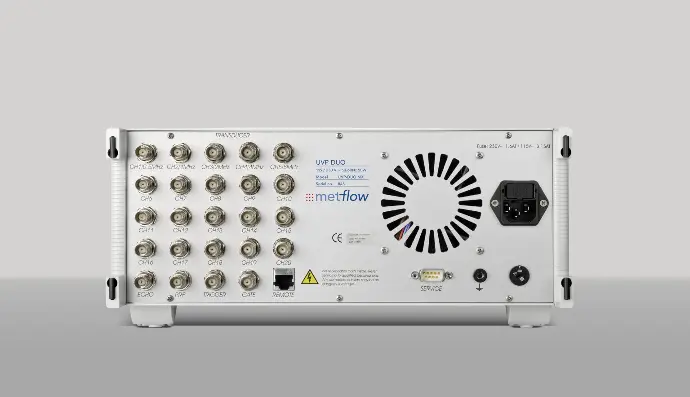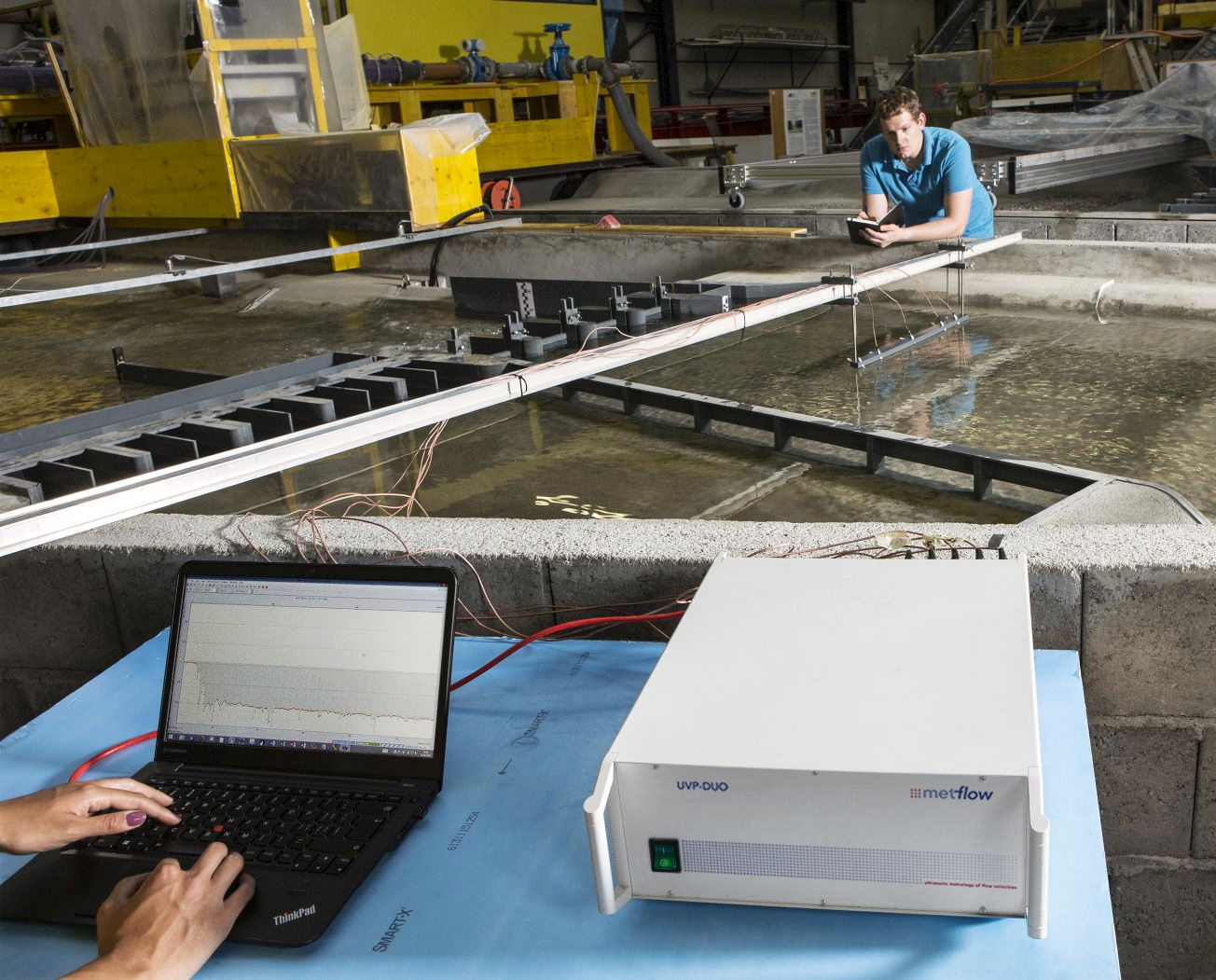UVP-DUO is Met-Flow’s fifth generation of instrument, it is the most precise, reliable and flexible UVP profiler to date.
Its large measuring ranges at high resolutions, its multiple inputs to connect up to 20 transducers, while being operated by a standard PC through a computer network, makes it the most versatile UVP instrument found on the market to date, covering a wide range of applications from small-scale laboratory experiments to outdoor field measurements.
First released in the early years 2000 as an IoT instrument ahead of its time, we have kept on developing various versions to date, continuously enhancing its hardware and updating its software. Some early users still use their UVP-DUO’s with full satisfaction, with nearly no service required besides the software updates we provide.
UVP-DUO

![]() Features
Features
Precise & reliable
- High velocity, space and time resolutions
- Accuracy below 1%
- Stable performances over time
Versatile
- Wide velocity, distance, time measuring ranges
- Control up to 20 transducers
- Numerous analysis modules available, including 2D/3D tools and ActiveX
Practical
- Remote-controlled by a standard PC via Ethernet
- Easy setting via a user-friendly controlling software
- Quick setup on any test rig
Durable
- Compact and sturdy design, low power consumption
- No planned obsolescence, regular software updates
- Almost no service required
Technical Specifications
Concept & design
Connection
Following four generations of stand-alone UVP instruments with included controlling PC, the original concept of UVP-DUO is to separate both measuring part and user interface, to avoid fast obsolescence of the latter. UVP-DUO can be considered as a measurement server, controlled remotely by a standard PC connected on the same computer network, via TCP/IP.
This gives more flexibility to the user, using existing network and computer facilities, placing UVP-DUO as close as possible to the measurement location, while controlling it either nearby, from a control room or from the one’s office.
Integrated multiplexer
Originally proposed as an option, we decided to integrate a 20 channels multiplexer into UVP-DUO to attach up to 20 transducers, to give the users more flexibility to address their experiment. Indeed it enables easy adaptation of one’s UVP setup over time, just by purchasing additional transducers when actually needed, avoiding costly hardware modification.
Multiple emitting frequencies
UVP-DUO can operate transducers in a wide emitting frequency range, from 0,5 MHz to 8 MHz, to cover a large field of applications. Low frequencies are used for large velocities and distances while high frequencies are utilized for their high spatial and velocity resolutions.
Then one single instrument can be used for various studies, and even exchanged between users of different labs, possibly just changing the type of transducer.

Functionalities
- Measurement of velocity profiles in almost any liquid, either transparent or opaque, such as water, waste water, slurry, oil, food, liquid metal, and many more.
- Real-time measurement and display of velocity profiles and echo amplitude, useful for process monitoring, quality control, risk management, sudden flow conditions change, etc.
- High flexibility of the profiler configuration for a wide variety of applications, from millimeter pipe sections to large open channel flows.
- Large set of analysis tools available: turbulence statistics, power spectrum, spatial correlation, flow-rate, and other relevant data.
- 2D and 3D flow mapping: multi-dimensional velocity measurement is possible combining several transducers in a grid array, and using specific software analysis modules.
- UVP ActiveX library: UVP acquisition software functions can be implemented in an integrative acquisition system compatible with ActiveX (Matlab®, Labview®, etc.), for instance to synchronize data collection with specific experiment events or to access to UVP-DUO demodulated echo signals.
Measurement ranges
Measurement ranges depends essentially on the following aspects of the UVP method:
- The selected transducer frequency: Low frequencies measure large velocities and long distances with higher emitted power and coarser resolutions, while high frequencies measure more confined flows with higher resolutions, both for velocity and space.
- The interdependence between the maximum measurable velocity and the maximum measurable depth, due to the Nyquist limit.
- The type of liquid: The speed of sound, specific to each measured medium, influences the velocity and distance scaling when transposing the UVP time-based signals to physical magnitudes.
- The intrinsic performances of the UVP profiler: memory capacity, internal clock, emitted power, noise filtering, etc.
More information about the above concepts in our FAQ page…
Please find hereafter typical measurement ranges taking into account the above mentioned aspects, with water as the reference measured liquid:
| Transducer Frequency [MHz] | Velocity range [m/s] | Velocity resolution [mm/s] | Distance range [m] | Spatial resolution [mm] | Time resolution: Acquisition time [msec] | Time resolution: Sampling frequency [Hz] |
|---|---|---|---|---|---|---|
| 0,5 | 0,36 52 | 1,4 203 | 3 0,021 | 5,92 | 132 2 | 8 500 |
| 1 | 0,18 51 | 0,7 199 | 3 0,011 | 2,96 | 132 2 | 8 500 |
| 2 | 0,09 49 | 0,3 193 | 3 0,006 | 1,48 | 132 1 | 8 4170 |
| 4 | 0,045 46 | 0,2 181 | 3 0,003 | 0,74 | 132 1 | 8 1000 |
| 8 | 0,023 41 | 0,1 161 | 3 0,002 | 0,37 | 132 1 | 8 1000 |
Velocity range Vrange: is the maximum velocity range UVP method can measure, for a given PRF (pulse repetition frequency) or corresponding distance range Pmax, constrained by the above mentioned Nyquist limit.
When velocity is measured with sign detection, velocity range becomes [-Vrange/2 ; +Vrange/2].
Distance range Pmax: Also called maximum depth, is the maximum reachable distance, which actually fixes the PRF (pulse repetition frequency) and consequently measurable velocity range Vrange (Nyquist limit).
Spatial resolution: corresponds to “channel width”, here calculated for an emitted US pulse with a length of 4 cycles, in water.
Time resolution: is given for 32 repetitions of US pulse emission.
Typical applications
- 0,5 MHz: environmental hydraulics, flow-rate measurement, rivers dynamic, dam construction, marine science, fermentation tank
- 1 MHz: jet flow, waste water, sludge thickener, metallurgy, environmental hydraulics, oil refinery
- 2 MHz: wave flow, tsunami flow, sedimentation pool, chemical reactor, oil transport
- 4 MHz: sediment transport, liquid metal, magnetic flow, rheology, food process, earth science, environmental hydraulics, turbulence
- 8 MHz: fundamental fluid mechanic, convection, crystal growth, microfluidics, biomedical
More details in our Applications section…
Technical specifications
| Acoustics | |
|---|---|
| Emitting frequency | 0,5 - 1 - 2 - 4 - 8 MHz |
| Emitting voltage on transducer | 30 - 60 - 90 - 150 V peak-peak |
| Emitted cycles per pulse (1) | 2 to 32 cycles, by step of 1 |
| Pulse repetition frequency (2) | 244 Hz to 444 kHz |
| Number of channels per velocity profile | 2 to 2048 |
| Receiving amplification | Exponential, time-dependent, for compensation of acoustic attenuation over distance |
| Spatial resolution - longitudinal (3) | Minimum 0,19 mm in water (emitting frequency and medium dependent) |
| Spatial resolution - lateral (4) | Defined by used transducer |
| Channel distance | Variable, from 0,37 mm in water (medium dependent) |
| Acquisition | |
|---|---|
| Velocity resolution | 1/256 of velocity range (1 LSB) |
| Raw echo acquisition | Both real-time digitalization (2 LSB) with velocity and on analog output (BNC) |
| Number of emission repetitions | 8 to 2048 |
| Sampling time / frequency (5) | Variable, down to 1 msec / 1 kHz |
| Doppler shift determination | Phase detection |
| Triggering | External signal (TTL on BNC) or manual/keyboard |
| Time delay between profiles | 0 to 10^9 msec / 300 hours |
| Recording capacity | Up to controlling computer storage capacity |
| Configuration parameters saving | Unlimited |
| Interface | |
|---|---|
| Measurement signals | 20 transducer connectors (BNC) |
| Control signals | Raw 'ECHO' output (max 0,7 V), pulse repetition frequency 'PRF' output, 'TRIGGER' input, window start 'GATE' output, 'REMOTE' connector, 'SERVICE' connector |
| Remote control interface | Ethernet 100 Base-T (RJ-45 remote connector) |
| Remote computer operating system | MS Windows® (up to Windows 10 32/64 bits) |
| Display | External display - up to controlling computer specifications |
| Environment | |
|---|---|
| Power supply | Selectable 100/230 V AC, 50/60 Hz |
| Size of instrument casing / weight | 34 x 13 x 40 cm / 9,3 kg |
| Operating conditions | Temperature in use: 0 - 40°C, storage: -20 - 60°C, relative humidity 30 - 80%, non-condensing |
| Packaging | Sturdy transport case on casters, 65 x 50 x 31 cm, offered |
(1) Increasing number of emitted cycles improves signal quality but decreases longitudinal resolution.
(2) Pulse repetition frequency is defined by the set maximum measurable depth, namely by the travelling time of the ultrasonic signal from the transducer to the furthest point and return.
(3) The least possible number of waves in a pulse is two. Longitudinal spatial resolution depends on ultrasonic frequency (wavelength) and also on the performances of the used transducer.
(4) For ultrasonic beam divergence values please refer to the UVP transducers specifications.
(5) Sampling time depends both on the travelling time of the ultrasonic signal to the maximum depth point and return, and on the number of emission repetitions.


